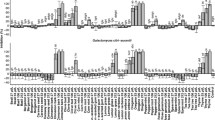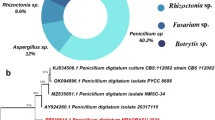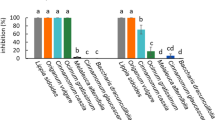Abstract
Penicillium digitatum and Geotrichum citri-aurantii are fungi that cause green mold and sour rot, respectively, both of which are postharvest diseases responsible for economic losses in oranges. Concerns about environmental and human health regarding agrochemicals necessitate the investigation of effective disease control alternatives. This study aimed to investigate the in vitro effect of seven essential oils (EOs) on the mycelial growth of G. citri-aurantii and P. digitatum in orange, to identify the EOs with the highest antifungal activity, and to determine the minimal inhibitory concentration (MIC) of the selected EOs. Additionally, the chemical composition of two batches of EOs from the same plant species was analyzed using gas chromatography with mass spectrometry (GC–MS), and the results were compared. The antifungal activity of the mixture of the major constituents of each selected EO was evaluated. According to the results, oregano, cinnamon bark, clove basil, and rosemary pepper EOs exhibited the most promising outcomes in inhibiting G. citri-aurantii and P. digitatum, with MIC of 0.25–3.0 μL. mL−1. Despite being extracted from the same plant species, the two EO batches showed different profiles of chemical constituents and proportions. Concerning the antifungal activity of the constituents, the mixture of the three major EO constituents displayed greater antifungal activity than the pure EO, with MIC of 0.25–1.00 μL. mL−1, suggesting an interaction among the mixture components. Therefore, using a mixture of the major constituents of EO represents a promising alternative to chemical fungicides commonly used for controlling postharvest diseases in oranges.




Similar content being viewed by others
Data Availability
The authors declare that the data will be available upon request.
References
Karoney, E.M.; Molelekoa, T.; Bill, M.; Siyoum, N.; Korsten, L.: Global research network analysis of fresh produce postharvest technology: innovative trends for loss reduction. Postharvest Biol. Technol. 208, 112642 (2024). https://doi.org/10.1016/j.postharvbio.2023.112642
Rovetto, E.I.; Luz, C.; La Spada, F.; Meca, G.; Riolo, M.; Cacciola, S.O.: Diversity of mycotoxins and other secondary metabolites recovered from blood oranges infected by Colletotrichum, Alternaria, and Penicillium species. Toxins 15, 407 (2023). https://doi.org/10.3390/toxins15070407
François, G.A.; Pontes, J.G.M.P.; Pereira, A.K.; Fill, T.P.: Exploring the Citrus Sour Rot pathogen: biochemical aspects, virulence factors, and strategies for disease management; a review. Fungal Biol. Rev. 41, 70–83 (2022)
Baigorria, C.G.; Cerioni, L.; Debes, M.A.; Ledesma, A.E.; Alastuey, P.; Tirado, M.; Volentini, S.I.; Rapisarda, V.A.: Antifungal Action of metallic nanoparticles against fungicide-resistant pathogens causing main postharvest lemon diseases. J. Fungi 10, 782 (2024). https://doi.org/10.3390/jof10110782
Alvarez, N.H.; Stegmayer, M.I.; Seimandi, G.M.; Pensiero, J.F.; Zabala, J.M.; Favaro, M.A.; Derita, M.G.: Natural products obtained from argentinean native plants are fungicidal against citrus postharvest diseases. Horticulturae 9, 562 (2023). https://doi.org/10.3390/horticulturae9050562
Fincheira, P.; Jofré, I.; Espinoza, J.; Levío-Raimán, M.; Tortella, G.; Oliveira, H.C.; Diez, M.C.; Quiroz, A.; Rubilar, O.: The efficient activity of plant essential oils for inhibiting Botrytis cinerea and Penicillium expansum: Mechanistic insights into antifungal activity. Microbiol. Res. 277, 127486 (2023). https://doi.org/10.1016/j.micres.2023.127486
Bilal, H.; Hashmi, M.S.: Combination of rosemary oil and potassium sorbate controls anthracnose in mango fruit by triggering defense-related enzymes. Physiol. Molecular Plant Pathol. (2023). https://doi.org/10.1016/j.pmpp.2023.102112
Wu, T.L.; Zhang, B.Q.; Luo, X.F.; Li, A.P.; Zhang, S.Y.; An, J.X.; Zhang, Z.J.; Liu, Y.Q.: Antifungal efficacy of sixty essential oils and mechanism of oregano essential oil against Rhizoctonia solani. Ind. Crops Prod. (2023). https://doi.org/10.1016/j.indcrop.2022.115975
Zhao, Y.; Yang, Y.H.; Ye, M.; Wang, K.B.; Fan, L.M.; Su, F.W.: Chemical composition and antifungal activity of essential oil from Origanum vulgare against Botrytis cinerea. Food Chem. (2021). https://doi.org/10.1016/j.foodchem.2021.130506
Xu, Y.; Wei, J.; Wei, Y.; Han, P.; Dai, K.; Zou, X.; Jiang, S.; Xu, F.; Wang, H.; Sun, J.; Shao, X.: Tea tree oil controls brown rot in peaches by damaging the cell membrane of Monilinia fructicola. Postharvest Biol. Technol. (2021). https://doi.org/10.1016/j.postharvbio.2021.111474
Vilela, E.S.D.; Terao, D.; De Queiroz, S.C.N.; Da Silva, A.M.; Maia, A.H.N.; Fracarolli, J.A.; Dorta, C.; Dos Santos, L.S.: Essential oils on the control of fungi causing postharvest diseases in mango. Braz. J. Microbiol. (2024). https://doi.org/10.1007/s42770-023-01237-2
Álvarez-García, S.; Moumni, M.; Romanazzi, G.: Antifungal activity of volatile organic compounds from essential oils against the postharvest pathogens Botrytis cinerea, Monilinia fructicola, Monilinia fructigena, and Monilinia laxa. Front. Plant Sci. 14, 1274770 (2023). https://doi.org/10.3389/fpls.2023.1274770
Chen, C.; Xue, Z.; Pristijono, P.; Golding, J.B.; Chen, G.; Li, Y.; Yang, H.: Effect of cinnamaldehyde on Rhizopus stolonifer and on the conservation of sweet potato. Food Qual. Saf. (2024). https://doi.org/10.1093/fqsafe/fyad072
Phyo, H.M.; Ju, J.; Al-Maqtari, Q.A.; Yao, W.: Evaluation of the synergistic antifungal effects of thymol and cinnamaldehyde combination and its mechanism of action against Rhizopus stolonifer in vitro and in vivo. Biocatal. Agric. Biotechnol.al. Agric. Biotechnol. (2023). https://doi.org/10.1016/j.bcab.2023.102658
Ben Miri, Y.; Nouasri, A.; Herrera, M.; Djenane, D.; Ariño, A.: Antifungal activity of menthol, eugenol and their combination against Aspergillus ochraceus and Aspergillus niger in vitro and in stored cereals. Foods 12, 2108 (2023). https://doi.org/10.3390/foods12112108
Bhunjun, C.S.; Phillips, A.J.L.; Jayawardena, R.S.; Promputtha, I.; Hyde, K.D.: Importance of molecular data to identify fungal plant pathogens and guidelines for pathogenicity testing based on Koch’s Postulates. Pathogens 10, 1096 (2021). https://doi.org/10.3390/pathogens10091096
White, T.J.; Bruns, T.; Lee, S.; Taylor, J.: Amplification and direct sequencing of fungal ribosomal RNA genes for phylogenetics. In: PCR Protocols. Elsevier, 315–322 (1990).
Viuda-Martos, M.; Ruiz-Navajas, Y.; Fernández-López, J.; Pérez-Álvarez, J.: Antifungal activity of lemon (Citrus lemon L.), mandarin (Citrus reticulata L.), grapefruit (Citrus paradisi L.) and orange (Citrus sinensis L.) essential oils. Food Control 19, 1130–1138 (2008). https://doi.org/10.1016/j.foodcont.2007.12.003
Broetto, L.; Coltro-Roncato, S.; Meinerz, C.C.; Dildey, O.D.F.; Pazdiora, P.C.; Gonçalves, E.D.V.; Moraes, A.J.; Henkemeier, N.P.; Kuhn, O.J.; Stangarlin, J.R.: Crescimento micelial e produção de microescleródios de macrophomina phaseolina confrontado com diferentes isolados de Trichoderma sp. Sci. Agrar. Parana. 13, 310–317 (2014). https://doi.org/10.18188/1983-1471/sap.v13n4p310-317
Al-Reza, S.M.; Rahman, A.; Ahmed, Y.; Kang, S.C.: Inhibition of plant pathogens in vitro and in vivo with essential oil and organic extracts of Cestrum nocturnum L. Pestic. Biochem. Physiol. 96, 86–92 (2010). https://doi.org/10.1016/j.pestbp.2009.09.005
Adams, R.P.: Identification of essential oil components by Gas chromatography/Mass Spectrometry, 4th ed. Allured Pub Corp (2007)
Conover, W.J.: Practical Nonparametric Statistics, 3rd edition, Wiley (1999).
Dunn, O.J.: Multiple comparisons using rank sums. Technometrics 6, 241–252 (1964). https://doi.org/10.1080/00401706.1964.10490181
R Core Team.: R: A language and environment for statistical computing_. R foundation for statistical computing, Vienna, Austria. https://www.R-project.org/ (2023).
Angane, M.; Swift, S.; Huang, K.; Butts, C.A.; Quek, S.Y.: Essential oils and their major components: an updated review on antimicrobial activities, mechanism of action and their potential application in the food industry. Foods 11, 464 (2022). https://doi.org/10.3390/foods11030464
Moussa, H.; El Omari, B.; Chefchaou, H.; Tanghort, M.; Mzabi, A.; Chami, N.; Remmal, A.: Action of thymol, carvacrol and eugenol on Penicillium and Geotrichum isolates resistant to commercial fungicides and causing postharvest citrus decay. Can. J. Plant Pathol. 43, 26–34 (2021). https://doi.org/10.1080/07060661.2020.1767692
Bounar, R.; Kkrimat, S.; Boureghda, H.; Dob, T.: Chemical analyses, antioxidant and antifungal effects of oregano and thyme essential oils alone or in combination against selected Fusarium species. Int. Food Res. J. 27, 66–77 (2019)
Mani-López, E.; Cortés-Zavaleta, O.; López-Malo, A.: A review of the methods used to determine the target site or the mechanism of action of essential oils and their components against fungi. SN Appl. Sci. 3, 44 (2021). https://doi.org/10.1007/s42452-020-04102-1
Khorram, F.; Ramezanian, A.; Saharkhiz, M.J.: In vitro activity of some essential oils against Penicillium digitatum. Adv. Horticultural Sci., 32, 487–493 (2018). https://doi.org/10.13128/ahs-22569
Wu, Y.; Duan, X.; Jing, G.; OuYang, Q.; Tao, N.: Cinnamaldehyde inhibits the mycelial growth of Geotrichum citri-aurantii and induces defense responses against sour rot in citrus fruit. Postharvest Biol. Technol. 129, 23–28 (2017). https://doi.org/10.1016/j.postharvbio.2017.03.004
Ma, Y.; Chen, C.; Li, Q.; Wang, W.; Xu, F.; Cheng, Y.; Dong, X.: Fungicidal activity of essential oils from cinnamomum cassia against the pathogenic fungi of panax notoginseng diseases. Chem. Biodivers. (2019). https://doi.org/10.1002/cbdv.201900416
Mrvová, M.; Medo, J.; Lakatošová, J.; Barboráková, Z.; Golian, M.; Mašková, Z.; Tančinová, D.: Vapor-phase essential oils as antifungal agents against Penicillium olsonii causing postharvest cherry tomato rot. Foods 13, 3202 (2024). https://doi.org/10.3390/foods13193202
Vasconcelos, N.G.; Croda, J.; Simionatto, S.: Antibacterial mechanisms of cinnamon and its constituents: a review. Microb. Pathog. 120, 198–203 (2018). https://doi.org/10.1016/j.micpath.2018.04.036
Parikh, L.; Agindotan, B.O.; Burrows, M.E.: antifungal activity of plant-derived essential oils on pathogens of pulse crops. Plant Dis. 105, 1692–1701 (2021). https://doi.org/10.1094/PDIS-06-20-1401-RE
Zhang, R.; Cui, Y.; Cheng, M.; Guo, Y.; Wang, X.; Wang, J.: Antifungal activity and mechanism of cinnamon essential oil loaded into mesoporous silica nanoparticles. Ind. Crops Prod. (2021). https://doi.org/10.1016/j.indcrop.2021.113846
Yang, C.H.; Yang, C.S.; Hwang, M.L.; Chang, C.C.; Li, R.X.; Chuang, L.Y.: Antimicrobial activity of various parts of cinnamomum cassia extracted with different extraction methods: antimicrobial activity of cinnamomum cassia. J. Food Biochem. 36, 690–698 (2012). https://doi.org/10.1111/j.1745-4514.2011.00584.x
Hilgers, F.; Habash, S.S.; Loeschcke, A.; Ackermann, Y.S.; Neumann, S.; Heck, A.; Klaus, O.; Hage-Hülsmann, J.; Grundler, F.M.W.; Jaeger, K.E.; Schleker, A.S.S.; Drepper, T.: heterologous production of β-caryophyllene and evaluation of its activity against plant pathogenic fungi. Microorganisms 9, 168 (2021). https://doi.org/10.3390/microorganisms9010168
Tian, F.; Woo, S.Y.; Lee, S.Y.; Chun, H.S.: p-Cymene and its derivatives exhibit ant aflatoxigenic activities against Aspergillus flavus through multiple modes of action. Appl. Biol. Chem. 61, 489–497 (2018). https://doi.org/10.1007/s13765-018-0382-4
Nóbrega, R.D.O.; Teixeira, A.P.D.C.; Oliveira, W.A.D.; Lima, E.D.O.; Lima, I.O.: Investigation of the antifungal activity of carvacrol against strains of Cryptococcus neoformans. Pharm. Biol. 54, 2591–2596 (2016). https://doi.org/10.3109/13880209.2016.1172319
Numpaque, M.A.; Oviedo, L.A.; Gil, J.H.; García, C.M.; Durango, D.L.: Thymol and carvacrol: biotransformation and antifungal activity against the plant pathogenic fungi Colletotrichum acutatum and Botryodiplodia theobromae. Trop. Plant Pathol. 36, 3–13 (2011). https://doi.org/10.1590/S1982-56762011000100001
Pereira, F.O.; Mendes, J.M.; Lima, E.O.: Investigation on mechanism of antifungal activity of eugenol against Trichophyton rubrum. Med. Mycol. 51, 507–513 (2013). https://doi.org/10.3109/13693786.2012.742966
Burt, S.: Essential oils: their antibacterial properties and potential applications in foods—a review. Int. J. Food Microbiol. 94, 223–253 (2004). https://doi.org/10.1016/j.ijfoodmicro.2004.03.022
Kumar, A.; Lal, R.K.: The consequence of genotype × environment interaction on high essential oil yield and its composition in clove basil (Ocimum gratissimum L.). Acta Ecol. Sin. 42, 633–640 (2022). https://doi.org/10.1016/j.chnaes.2021.06.002
Aljaafari, M.N.; AlAli, A.O.; Baqais, L.; Alqubaisy, M.; AlAli, M.; Molouki, A.; Ong-Abdullah, J.; Abushelaibi, A.; Lai, K.S.; Lim, S.H.E.: An overview of the potential therapeutic applications of essential oils. Molecules 26, 628 (2021). https://doi.org/10.3390/molecules26030628
FAPESP.: Fungicida à base de óleos essenciais combate pragas da cultura de soja. URL https://pesquisaparainovacao.fapesp.br/fungicida_a_base_de_oleos_essenciais_combate_pragas_da_cultura_de_soja/2852 (2023). Accessed 22 September 2024
Honorato, J.: Fungicida à base de óleos essenciais combate pragas de soja. URL https://agro2.com.br/tecnologia/fungicida-oleos-essenciais-combate-pragas-soja/ (2023). Accessed 22 September 2024.
Acknowledgements
The authors acknowledge the resources granted by the Fundação de Amparo à Pesquisa do Estado de São Paulo—FAPESP 2018/25318-7 and Conselho Nacional de Desenvolvimento Científico e Tecnológico—CNPq 407421_2021-1, as well as for the granting of a doctoral scholarship (CNPq 140679/2022-7). They also thanks Alfacitrus – Produção e Comércio de Citrus for their support in the research project. Special thanks also to Mr. Marley Mendonça Tavares and Mrs. Debora Renata Cassoli de Souza Dutra for their support in GC-MS analysis.
Author information
Authors and Affiliations
Corresponding author
Ethics declarations
Conflict of interest
The authors declare no conflicts of interest that may have influenced the work of this article.
Supplementary Information
Below is the link to the electronic supplementary material.
Rights and permissions
Springer Nature or its licensor (e.g. a society or other partner) holds exclusive rights to this article under a publishing agreement with the author(s) or other rightsholder(s); author self-archiving of the accepted manuscript version of this article is solely governed by the terms of such publishing agreement and applicable law.
About this article
Cite this article
da Silva, A.M., Terao, D., Vilela, E.S.D. et al. Efficiency of Essential Oils and Their Constituents in the Control of Geotrichum citri-aurantii and Penicillium digitatum of Oranges. Arab J Sci Eng (2025). https://doi.org/10.1007/s13369-024-09948-w
Received:
Accepted:
Published:
DOI: https://doi.org/10.1007/s13369-024-09948-w




